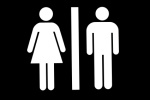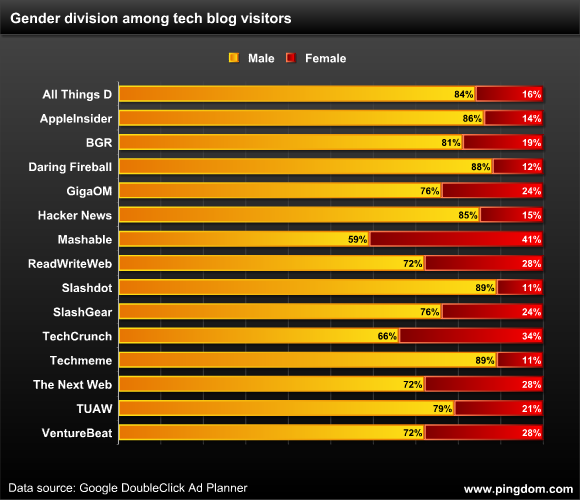 Tech is generally thought of as a male-dominated field, so it’s not surprising to see that visitors to tech blogs are predominantly male. What you might find a bit sad is just how massively the men outweigh the women.
Tech is generally thought of as a male-dominated field, so it’s not surprising to see that visitors to tech blogs are predominantly male. What you might find a bit sad is just how massively the men outweigh the women.
To find out what the balance looked like, we picked out a group of popular tech blogs (and a couple of tech blog aggregators) and examined how many of their website visitors are male versus female with the help of demographics data from Google’s DoubleClick Ad Planner.
The sites included in this survey are: TechCrunch, GigaOM, Mashable, ReadWriteWeb, Techmeme, Slashdot, The Next Web, Slashgear, Hacker News, Venturebeat, TUAW, BGR, Daring Fireball, All Things D, and AppleInsider.
Male vs. female site visitors
We can do a lot of talking, but the easiest and clearest way to show you how the site visitors to these sites are divided is simply to… show you.

We were tempted to go with blue and pink for the chart, but we’d never hear the end of it. 😉
The stats are averaged for the United States, the United Kingdom, Brazil, France, Italy, Japan, Germany, Spain and Switzerland. These are the only countries that have demographics data in DoubleClick Ad Planner, which as we mentioned was our data source.
The results:
- Most male-dominated sites: Techmeme, Slashdot and John Gruber’s Daring Fireball all have close to 90% male visitors. Hacker News and AppleInsider weren’t far behind.
- Least male-dominated sites: Mashable was the least male-dominated of the sites (59%), followed by TechCrunch (66%).
- The average for the sites in this survey is 78% male visitors, 22% female. If we look at just the United States, the average is 75% male visitors, 25% female.
Social networks tend to have a pretty even distribution between men and women overall, in many cases even being female dominated (here is a survey from 2009). This may explain why Mashable had more female visitors than any of the other sites in this survey; the site has a pretty strong focus on social media. Another reason may simply be that it’s considered a more mainstream blog.
The million-dollar question
Why do some of these sites attract so few women? It would be interesting to hear your take.
A quick note about the data source: Google bases its demographics data on a variety of data sources. There is unfortunately a certain lack of transparency regarding exactly what data sources those are and how Google estimates the amount of male versus female visitors to sites.


























